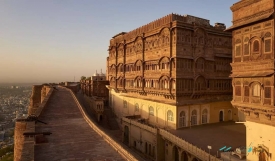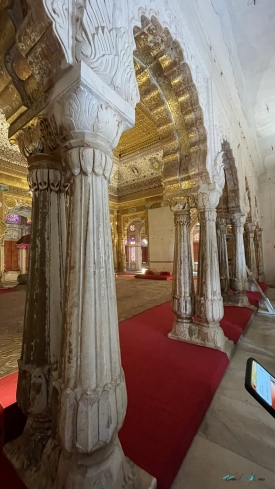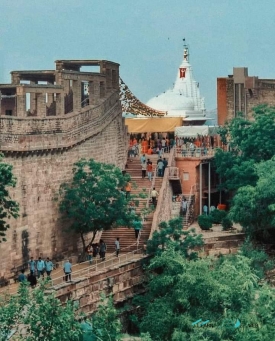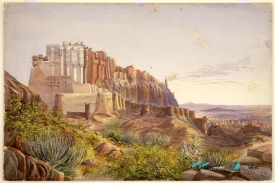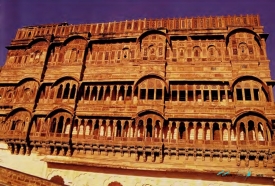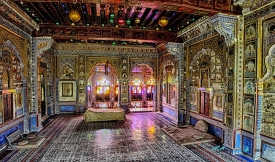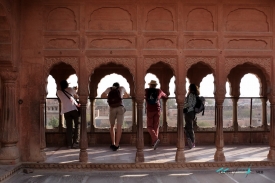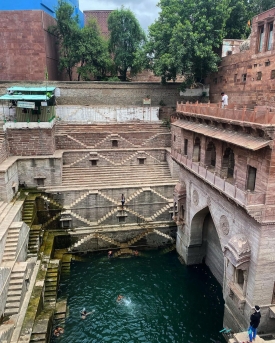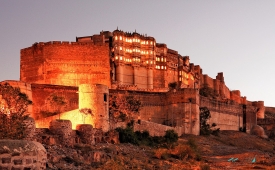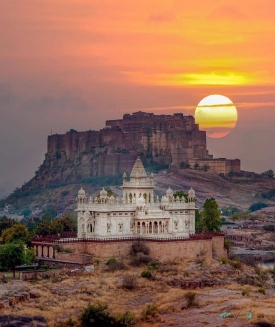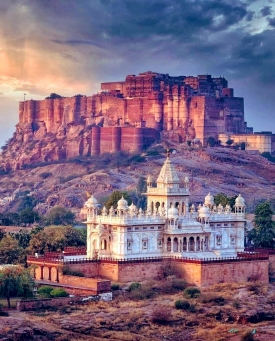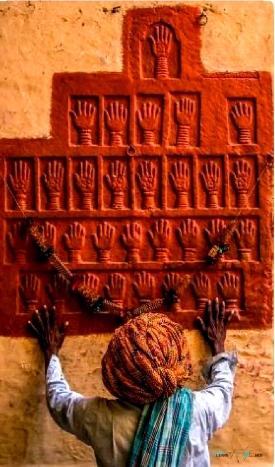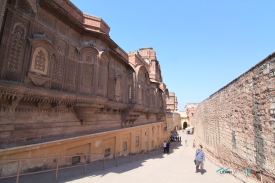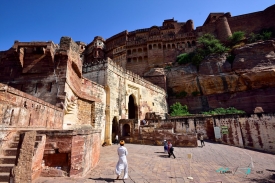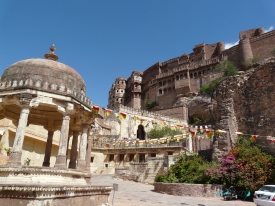Mehrangarh Fort is located in the city of Jodhpur, in the Indian state of Rajasthan. This massive 15th-century fort is situated on a rocky hill, 125 meters above the plain, and is surrounded by a ten-kilometre-long high wall with eight gates and countless bastions. Invisible from the outside, this fort has four gates connected by winding paths. Inside the fort there are many magnificent palaces, halls, temples, wonderfully carved doors and barred windows. Among the most prominent halls are: Moti Mahal, Phool Mahal, Sheesh Mahal, Sileh Khana, Daulat Khana, etc. Its palaces contain an amazing collection of royal Indian furniture.
This fort is one of the oldest in India and is a symbol of India's rich past. Rao Jodha, chief of the Rathore clan, is credited with founding Jodhpur (1459). Rao Jodha was one of the 24 sons of Raja Ranmal. He became the fifteenth ruler of the Rathore clan. A year after taking the reins of government, Rao Jodha began to feel that the old Mandore fort was not safe. He presented the idea of building a new fort on a hill 9 km from his then fort. This hill was known as Bhor Chidiyatunk, because many birds lived there. Rao Jodha laid the foundation for the fort on this hill on May 12, 1459. Maharaj Jaswant Singh (1638-78) completed it.
Basically, the fort has seven gates (pol) (the eighth gate is secret). The first door has sharp nails to protect it from attack by elephants. Jaipol gate included in other gates was built in 1806 by Maharaj Man Singh after his conquest of Jaipur and Bikaner. The Fateh Pol or Victory Gate was built by Maharaja Ajit Singh to commemorate his victory over the Mughals.
Rao Jodha had a great reverence for Chamunda Mata. Chamunda is the Kuldevi of the rulers of Jodhpur. Rao Jodha built the Chamunda Mata temple near the Mehrangarh Fort in 1460 and installed the idol. The doors of the temple were also opened to the general public. Chamunda Maa was the Kuldevi not only of the rulers but also of the majority of the residents of Jodhpur and even today this goddess is worshiped by millions of people. Special poojas are offered here during Navratri.
In the foundations of the Mehrangarh Fort, to ensure that the new site would prove auspicious, a Meghwal caste man named "Raja Ram Meghwal" was buried alive in the foundations and volunteered his services as this was considered auspicious. in those days. "Raja Ram Meghwal" was promised that in return the Rathores, a Hindu Rajput clan, would take care of his family. His family was granted land and to this day his descendants still live in Raj Bag near Soor Sagar. In the Holi festival, the clouds of clouds have the right to go to the fort with a melody, which no another caste has. Rajaram was born in Kadela Gautra from the womb of Kesar Devi and his father's name was Mohansi.
Inside the fort is the Mehrangarh museum, which has multiple galleries, which preserve a rich collection of miniatures, musical instruments, costumes and furniture. Within its walls, a large part of the excellently preserved original cannons are preserved.
This fort is one of the oldest in India and is a symbol of India's rich past. Rao Jodha, chief of the Rathore clan, is credited with founding Jodhpur (1459). Rao Jodha was one of the 24 sons of Raja Ranmal. He became the fifteenth ruler of the Rathore clan. A year after taking the reins of government, Rao Jodha began to feel that the old Mandore fort was not safe. He presented the idea of building a new fort on a hill 9 km from his then fort. This hill was known as Bhor Chidiyatunk, because many birds lived there. Rao Jodha laid the foundation for the fort on this hill on May 12, 1459. Maharaj Jaswant Singh (1638-78) completed it.
Basically, the fort has seven gates (pol) (the eighth gate is secret). The first door has sharp nails to protect it from attack by elephants. Jaipol gate included in other gates was built in 1806 by Maharaj Man Singh after his conquest of Jaipur and Bikaner. The Fateh Pol or Victory Gate was built by Maharaja Ajit Singh to commemorate his victory over the Mughals.
Rao Jodha had a great reverence for Chamunda Mata. Chamunda is the Kuldevi of the rulers of Jodhpur. Rao Jodha built the Chamunda Mata temple near the Mehrangarh Fort in 1460 and installed the idol. The doors of the temple were also opened to the general public. Chamunda Maa was the Kuldevi not only of the rulers but also of the majority of the residents of Jodhpur and even today this goddess is worshiped by millions of people. Special poojas are offered here during Navratri.
In the foundations of the Mehrangarh Fort, to ensure that the new site would prove auspicious, a Meghwal caste man named "Raja Ram Meghwal" was buried alive in the foundations and volunteered his services as this was considered auspicious. in those days. "Raja Ram Meghwal" was promised that in return the Rathores, a Hindu Rajput clan, would take care of his family. His family was granted land and to this day his descendants still live in Raj Bag near Soor Sagar. In the Holi festival, the clouds of clouds have the right to go to the fort with a melody, which no another caste has. Rajaram was born in Kadela Gautra from the womb of Kesar Devi and his father's name was Mohansi.
Inside the fort is the Mehrangarh museum, which has multiple galleries, which preserve a rich collection of miniatures, musical instruments, costumes and furniture. Within its walls, a large part of the excellently preserved original cannons are preserved.



